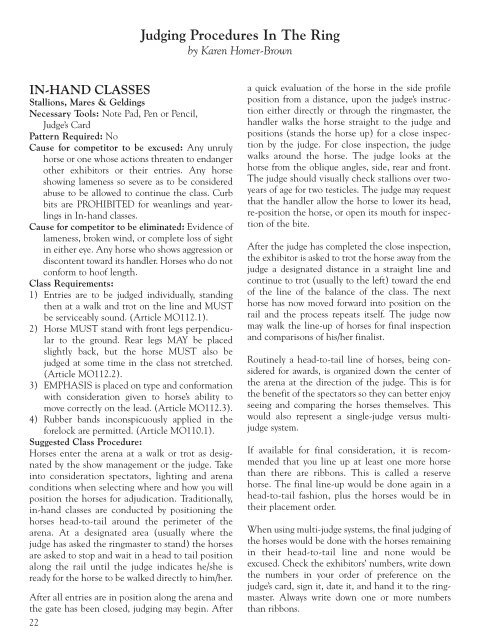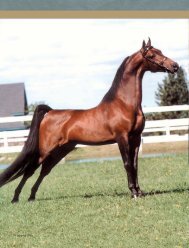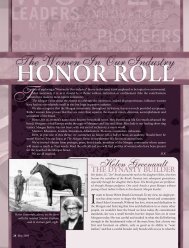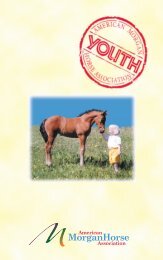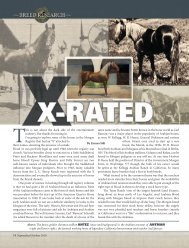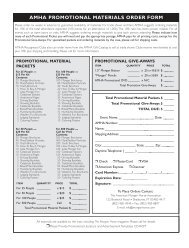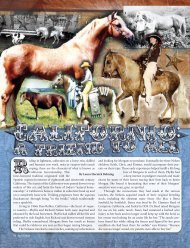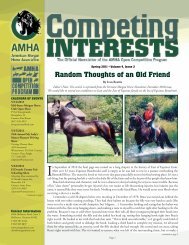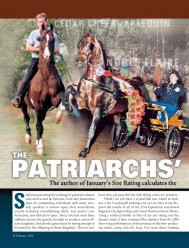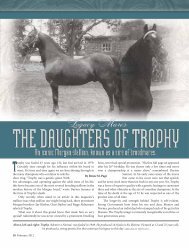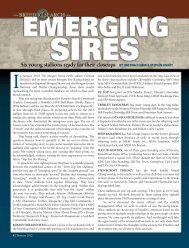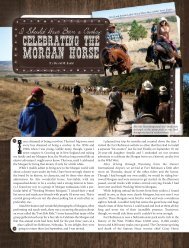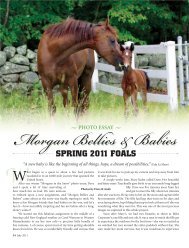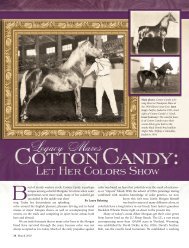Judging School Handbook - American Morgan Horse Association
Judging School Handbook - American Morgan Horse Association
Judging School Handbook - American Morgan Horse Association
You also want an ePaper? Increase the reach of your titles
YUMPU automatically turns print PDFs into web optimized ePapers that Google loves.
<strong>Judging</strong> Procedures In The Ringby Karen Homer-BrownIN-HAND CLASSESStallions, Mares & GeldingsNecessary Tools: Note Pad, Pen or Pencil,Judge’s CardPattern Required: NoCause for competitor to be excused: Any unrulyhorse or one whose actions threaten to endangerother exhibitors or their entries. Any horseshowing lameness so severe as to be consideredabuse to be allowed to continue the class. Curbbits are PROHIBITED for weanlings and yearlingsin In-hand classes.Cause for competitor to be eliminated: Evidence oflameness, broken wind, or complete loss of sightin either eye. Any horse who shows aggression ordiscontent toward its handler. <strong>Horse</strong>s who do notconform to hoof length.Class Requirements:1) Entries are to be judged individually, standingthen at a walk and trot on the line and MUSTbe serviceably sound. (Article MO112.1).2) <strong>Horse</strong> MUST stand with front legs perpendicularto the ground. Rear legs MAY be placedslightly back, but the horse MUST also bejudged at some time in the class not stretched.(Article MO112.2).3) EMPHASIS is placed on type and conformationwith consideration given to horse’s ability tomove correctly on the lead. (Article MO112.3).4) Rubber bands inconspicuously applied in theforelock are permitted. (Article MO110.1).Suggested Class Procedure:<strong>Horse</strong>s enter the arena at a walk or trot as designatedby the show management or the judge. Takeinto consideration spectators, lighting and arenaconditions when selecting where and how you willposition the horses for adjudication. Traditionally,in-hand classes are conducted by positioning thehorses head-to-tail around the perimeter of thearena. At a designated area (usually where thejudge has asked the ringmaster to stand) the horsesare asked to stop and wait in a head to tail positionalong the rail until the judge indicates he/she isready for the horse to be walked directly to him/her.After all entries are in position along the arena andthe gate has been closed, judging may begin. After22a quick evaluation of the horse in the side profileposition from a distance, upon the judge’s instructioneither directly or through the ringmaster, thehandler walks the horse straight to the judge andpositions (stands the horse up) for a close inspectionby the judge. For close inspection, the judgewalks around the horse. The judge looks at thehorse from the oblique angles, side, rear and front.The judge should visually check stallions over twoyearsof age for two testicles. The judge may requestthat the handler allow the horse to lower its head,re-position the horse, or open its mouth for inspectionof the bite.After the judge has completed the close inspection,the exhibitor is asked to trot the horse away from thejudge a designated distance in a straight line andcontinue to trot (usually to the left) toward the endof the line of the balance of the class. The nexthorse has now moved forward into position on therail and the process repeats itself. The judge nowmay walk the line-up of horses for final inspectionand comparisons of his/her finalist.Routinely a head-to-tail line of horses, being consideredfor awards, is organized down the center ofthe arena at the direction of the judge. This is forthe benefit of the spectators so they can better enjoyseeing and comparing the horses themselves. Thiswould also represent a single-judge versus multijudgesystem.If available for final consideration, it is recommendedthat you line up at least one more horsethan there are ribbons. This is called a reservehorse. The final line-up would be done again in ahead-to-tail fashion, plus the horses would be intheir placement order.When using multi-judge systems, the final judging ofthe horses would be done with the horses remainingin their head-to-tail line and none would beexcused. Check the exhibitors’ numbers, write downthe numbers in your order of preference on thejudge’s card, sign it, date it, and hand it to the ringmaster.Always write down one or more numbersthan ribbons.


